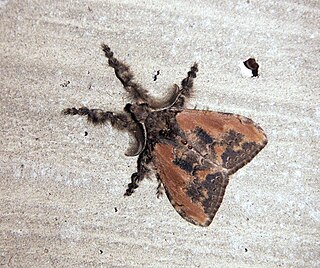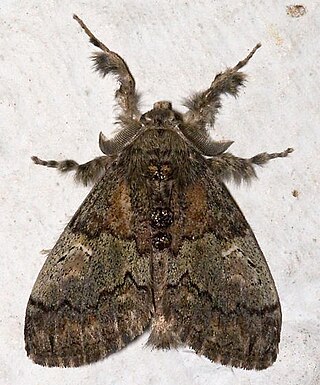
Olene mendosa, the brown tussock moth or hairy tussock moth, is a species of moth in the family Erebidae. The species was first described by Jacob Hübner in 1823. It is found in India, Bangladesh, Sri Lanka, Indonesia, Taiwan, Thailand and Australia.
Chrismania is a monotypic moth genus of the family Crambidae. Its only species, Chrismania pictipennalis, is found in North America, where it has been recorded from southern California and Arizona. Both the genus and species were first described by William Barnes and James Halliday McDunnough in 1914.

Dasychira is a genus of tussock moths in the family Erebidae described by Jacob Hübner in 1809. They are well distributed all over Africa, Europe, North America, Madagascar, Japan, China, India, Sri Lanka, Myanmar, Java and Australia.

Dasychira grisefacta, the pine tussock or grizzled tussock, is a moth of the family Erebidae. The species was first described by Harrison Gray Dyar Jr. in 1911. It is found in North America in Alberta, from British Columbia to Arizona and Oregon, in New Mexico, Montana, South Dakota and North Dakota.

Dasychira plagiata, the northern pine tussock or northern conifer tussock, is a moth of the family Erebidae. The species was first described by Francis Walker in 1865. It is found in North America from Newfoundland and Labrador to Alberta, in Massachusetts, New York and North Carolina.

Dasychira basiflava, the yellow-based tussock, is a moth of the family Erebidae. The species was first described by Alpheus Spring Packard in 1865. It is found in North America from Massachusetts and southern Ontario west to Iowa, Texas, south to South Carolina and possibly Florida. It is also found in Southeastern Alaska.
Hellinsia unicolor is a moth of the family Pterophoridae described by William Barnes and James Halliday McDunnough in 1913. It is found in North America, including Florida, Mississippi, Georgia and Kentucky.

Calephelis perditalis, also known as the rounded metalmark or lost metalmark, is a species of butterfly in the family Riodinidae. It is found in Texas in the United States and Mexico, south to Venezuela. The species was first described by William Barnes and James Halliday McDunnough in 1918.

Orgyia pseudotsugata, the Douglas-fir tussock moth, is a moth of the subfamily Lymantriinae first described by James Halliday McDunnough in 1921. It is found in western North America. Its population periodically irrupts in cyclical outbreaks. The caterpillars feed on the needles of Douglas fir, true fir, and spruce in summer, and moths are on the wing from July or August to November.

Euphilotes battoides, the square-spotted blue or buckwheat blue, is a species of butterfly of the family Lycaenidae.
Negalasa is a monotypic snout moth genus. Its one species, Negalasa fumalis, is found in the US state of Arizona. Both the genus and species were described by William Barnes and James Halliday McDunnough in 1913 in the same paper.
Crambidia impura is a moth of the family Erebidae. It was described by William Barnes and James Halliday McDunnough in 1913. There are two disjunct populations. It has been recorded from southern Rocky Mountain states, the Yukon and northern British Columbia and Alberta.
Cisthene conjuncta, the white-streaked lichen moth, is a moth of the family Erebidae. It was described by William Barnes and James Halliday McDunnough in 1913. It is found in southern Texas.
Xubida dentilineatella is a moth in the family Crambidae. It was described by William Barnes and James Halliday McDunnough in 1913. It is found in Mexico and the southern United States, where it has been recorded from Arizona.
Evergestis vinctalis is a moth in the family Crambidae. It was described by William Barnes and James Halliday McDunnough in 1914. It is found in North America, where it has been recorded from Alberta, Arizona, British Columbia, California, Colorado, Kansas, Montana, Nevada, New Mexico, Texas and Wyoming.
Dasychira dorsipennata, the sharp-lined tussock or hardwood tussock moth, is a species of tussock moth in the family Erebidae. It was first described by William Barnes and James Halliday McDunnough in 1919 and it is found in North America.

Dasychira meridionalis, the southern tussock moth, is a species of tussock moth in the family Erebidae. It was first described by William Barnes and James Halliday McDunnough in 1913, and it is found in North America.

Glena nigricaria is a species of moth in the family Geometridae first described by William Barnes and James Halliday McDunnough in 1913. It is found in Central and North America.









